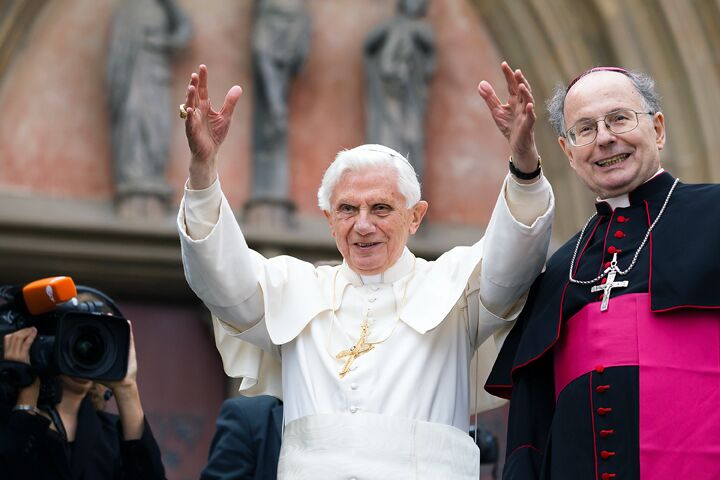
Pope’s Real German Agenda
In October 2010, Pope Benedict created the Pontifical Council for Promoting New Evangelization to work to especially stem the impact of secularism in European countries. With his visit to Germany he is literally facing down the secularist movement in Europe’s heartland, its leading economy, which he knows is now poised to dominate the Continent in what pundits are already identifying as the Fourth Reich.
A few days before his departure for Germany, the pope declared, “Today we live in an age of new evangelization. Vast horizons are opening to the announcement of the gospel, while regions of ancient Christian tradition are called to rediscover the beauty of the faith.” Benedict xvi concluded the Angelus prayer at his summer residence of Castel Gandolfo by praying to Mary “for priestly, religious and lay vocations to arise throughout the church, in order to serve the new evangelization.“
The day before, in a message specifically designed for his German audience, Pope Benedict intoned of his visit to his homeland, “This is not religious tourism; still less is it a ‘show.’ Its significance is well expressed in the motto accompanying these days: ‘Where God is, there lies the future.’ What this means is that we must restore God to our horizon …. Thus, over these days, let us commit ourselves to seeing God again, to becoming people who bring the light of hope into the world.”
This is the most potent clarion call for crusade that has been made by any pope in generations. To bring it into full effect, Benedict knows he needs to have Rome’s traditional protector, and enforcer, Germany, onside and active at the forefront of the battle. It was similar inspiration that motivated many a German soldier to go into battle in World War i wearing the military motto “God with us” impressed on his government-issue belt buckle.
The terms “Holy Roman” and “German” were used in juxtaposition from 1512 to describe an empire that lasted 800 years under Teutonic rule.
According to Germany’s London embassy, Holy Roman Empire was “The term used for the empire, which emerged from the East-Franconian Empire as of 962, with the coronation of Otto i as emperor; as of 1512 it was officially called the Holy Roman Empire of the German Nation—expressing, on the one hand, a claim to power as the successor to the ‘Imperium Romanum’ of Antiquity, and on the other, highlighting the religious role of the emperor. The ‘Reich’ survived for more than 800 years until in 1806, shortly after the formation of the Confederation of the Rhine and at the instruction of Napoleon, Franz ii, the Habsburg monarch, laid down the imperial crown.”
The crown referred to is the very crown of Charlemagne, king of the Franks and emperor of the Holy Roman Empire of the ninth century. Speaking of that crown being a traditional symbol of European unity, the recently deceased last claimant to it, Otto von Habsburg, declared, “Now we do possess a European symbol which belongs to all nations equally. This is the crown of the Holy Roman Empire, which embodies the tradition of Charlemagne, the ruler of a united Occident” (The Social Order of Tomorrow).
There are those who would dearly love for a royal representative of Teutonic Catholic imperialism to take up that crown again. “It is in rightist Catholic circles in Germany that one discovers the ‘love for monarchy’ today, theologian David Berger reports in a talk with German-Foreign-Policy.com. Berger was active in rightist Catholic circles for a long time. According to his narrative, for example, the founder of an officially recognized academy, who maintains until today good relations with Benedict xvi, believes that after a kind of divine intervention ‘a Christian monarchy again will come into being, in which the aristocracy will play anew a significant role.’ Part of the German nobility is close to organizations of rightist Catholicism, for instance Opus Dei. Experts name the houses of Habsburg and Guttenberg in particular” (German-Foreign-Policy.com, September 22; translation ours).
With the recent death of Habsburg, a prime contender for that crown is no more.
But there is a young Frank, of the house of Guttenberg, who might just fit the bill.
What is largely unseen by most commentators on the European scene today is the power of German right-wing Catholic monarchists who are the real movers and shakers behind the scenes in seeking a revival of that “Holy Roman Empire of the German Nation.”
Pope Benedict is most aware of the power and influence that these elites exert in politics, economy, industry, the military and education within Germany. This power has been largely hidden from the German masses since World War ii. Yet it is now beginning to assert itself more aggressively.
It is to these elites that this German pope presents most appeal as they hold the key to bridging the gap between Rome and Berlin that is so vital to the final phase of the revival of both the Vatican’s and German imperialists’ vision of a Fourth Reich, a literal resurrection of the “Holy Roman Empire of the German Nation.”
